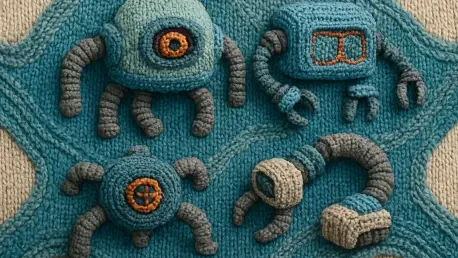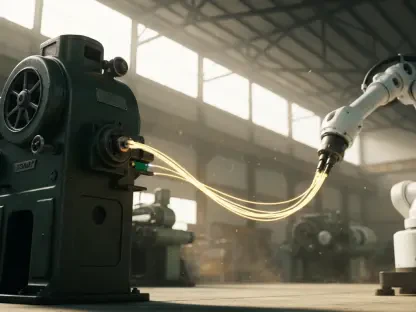Imagine a world where robots can seamlessly blend into their surroundings, morphing their shapes to navigate treacherous terrains or evade detection during critical missions. This isn’t science fiction but a tangible reality being shaped by an innovative technology—knitted textile metasurfaces. These programmable fabric structures are redefining adaptability in soft robotics and wearable tech, drawing inspiration from nature’s most elusive creatures. As industries strive for materials that combine flexibility with dynamic functionality, this cutting-edge development offers a glimpse into a future where fabrics do more than cover—they transform.
Core Innovations Behind the Technology
Knitted textile metasurfaces represent a breakthrough in material science, characterized by their ability to dynamically alter shape and appearance. Unlike traditional rigid robotic systems, these fabrics are engineered to be soft and pliable, enabling complex deformations through carefully designed stitch patterns. This technology, inspired by biological adaptability seen in organisms like chameleons, allows for real-time responses to environmental cues, positioning it as a game-changer in fields requiring stealth and versatility.
At the heart of this innovation lies geometry-driven programming, a method that uses stitch arrangements to dictate fabric behavior. By manipulating the structure of the knit, engineers can induce specific deformations without the need for specialized or costly yarns. This approach ensures scalability, making it feasible to apply across various applications while maintaining stability under diverse conditions such as temperature fluctuations or mechanical stress.
The significance of this structural focus cannot be overstated. It shifts the paradigm from relying on external mechanisms to embedding intelligence directly into the material. Such a design philosophy not only reduces complexity in manufacturing but also enhances the potential for customization, catering to specific needs in robotics or defense sectors with precision.
Performance and Functional Capabilities
One of the standout features of these metasurfaces is their morphing prowess, encompassing a range of deformations like non-Euclidean morphing and Gaussian transformations. These capabilities allow the fabric to adopt intricate, non-linear shapes or curvature-driven alterations, mimicking natural forms with startling accuracy. Inflation-induced shape shifts further add to their utility, enabling soft robots to expand or contract as needed for specific tasks.
This adaptability translates into remarkable functionality, particularly in challenging environments. For instance, soft robots equipped with these materials can squeeze through narrow spaces during search and rescue operations or alter their surface texture to blend into varied backgrounds for stealth missions. The ability to perform such tasks without bulky hardware underscores the efficiency and practicality of this technology in real-world scenarios.
Moreover, the performance of these textiles remains consistent across repeated cycles of deformation, a critical factor for long-term use. While challenges in achieving pinpoint precision persist, ongoing refinements in stitch geometry are steadily closing this gap. The balance between flexibility and control positions this technology as a reliable choice for applications demanding both durability and responsiveness.
Applications Transforming Industries
The implications of knitted textile metasurfaces extend far beyond academic research, with transformative potential in multiple sectors. In soft robotics, they enable machines to undertake complex tasks such as object manipulation in cluttered spaces or covert operations requiring camouflage. Their lightweight and adaptive nature makes them ideal for scenarios where traditional rigid robots fall short.
In wearable technology, these fabrics open up possibilities for adaptive clothing that can change appearance for military camouflage or wildlife observation. Urban applications are equally promising, with concepts like thermoregulating garments that adjust to temperature changes, enhancing comfort and energy efficiency for everyday consumers. This versatility highlights the broad appeal of the technology across both specialized and mainstream markets.
Additionally, the defense sector stands to benefit significantly from materials that offer real-time adaptability. Imagine uniforms that not only conceal soldiers but also morph to provide tactical advantages in dynamic combat zones. Such innovations could redefine strategic operations, blending cutting-edge science with practical deployment in high-stakes environments.
Challenges and Areas for Improvement
Despite the promise, several hurdles remain in the path to widespread adoption of this technology. Maintaining consistent performance over numerous deformation cycles poses a technical challenge, as wear and tear can impact the fabric’s responsiveness. Engineers are actively exploring ways to enhance material durability to ensure reliability in demanding conditions.
Market and regulatory barriers also present obstacles, especially in defense and consumer applications. Stringent standards for safety and performance must be met, which can slow down the integration process. Addressing these concerns requires collaboration between researchers, industry stakeholders, and policymakers to establish frameworks that support innovation while safeguarding interests.
Current efforts to overcome these limitations include rigorous real-world testing and exploration of advanced materials that complement the geometry-driven approach. From 2025 onward, research initiatives are expected to focus on hybrid solutions that combine durability with precision, paving the way for broader acceptance and implementation across sectors.
Final Thoughts on the Path Ahead
Looking back, the journey of knitted textile metasurfaces showcases a remarkable fusion of bio-inspired design and engineering ingenuity. Their ability to morph and camouflage has already demonstrated substantial potential in reshaping soft robotics and wearable technology. The successful integration of programmable behavior into fabric structures marks a significant milestone in material science.
Moving forward, the next steps involve addressing lingering technical challenges through collaborative research and enhanced testing protocols. Exploring hierarchical textile structures could offer finer control, while partnerships with industries might accelerate practical deployment. As solutions emerge, the vision of seamlessly adaptive robots and clothing inches closer to reality, promising to redefine human interaction with technology.









